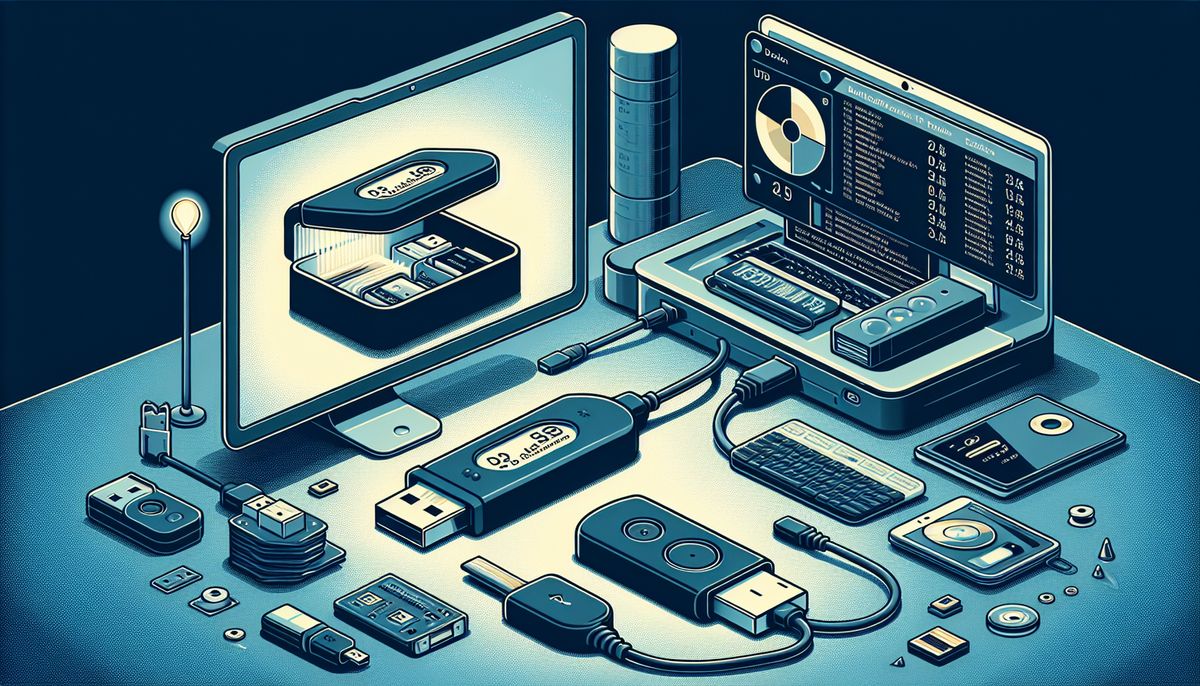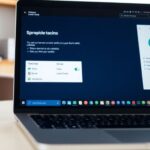Creating a bootable USB drive is an essential skill for anyone who needs to install or repair an operating system. Rufus is a popular, free, open-source application that simplifies the process of creating a bootable USB drive for Windows, Linux, and other operating systems. This article guides you through the steps of using Rufus to create a bootable USB drive, with a focus on Windows 11, and provides additional insights into alternative methods and advanced features.
Key Takeaways
- Rufus is a versatile tool that can create bootable USB drives for various operating systems, including Windows 11.
- The process of creating a bootable USB with Rufus involves selecting the appropriate ISO file, configuring settings, and starting the creation process.
- For Windows 11, users can download the ISO file directly from Microsoft or use Rufus’s built-in feature to download it.
- Alternative methods for creating bootable USB drives include using the Windows Media Creation Tool, Command Prompt, or other Rufus alternatives like Ventoy.
- Advanced Rufus features include creating multi-ISO bootable USB drives and using the tool to protect your PC with a bootable antivirus USB drive.
Getting Started with Rufus
Choosing the Right Rufus Version
When we’re gearing up to create a bootable USB drive, picking the correct version of Rufus is crucial. The latest version of Rufus is typically the best choice, as it includes the most recent features and bug fixes. However, if you’re working with older hardware or operating systems, you might need to opt for an earlier release. Here’s a quick rundown on how to ensure you’re downloading the right Rufus for your needs:
- Visit the official Rufus website.
- Check the version history to see the changes and improvements.
- Determine if your system requires a specific version based on compatibility notes.
It’s essential to use a version of Rufus that’s compatible with your system to avoid any hiccups during the bootable USB creation process.
Once you’ve selected the appropriate version, download it directly from the Rufus website to ensure you’re getting a safe and verified copy. Remember, using the most up-to-date version is generally the best practice unless you have a specific reason to do otherwise.
Downloading and Installing Rufus
Once you’ve decided to create a bootable USB drive, the next step is to download and install Rufus. It’s a straightforward process that we’ll walk through together. First, head over to the Rufus official website and look for the latest version. It’s important to grab the most recent release to ensure compatibility with newer operating systems like Windows 11, where features like Secure Boot and Windows Hello enhance security and accessibility.
After downloading Rufus, locate the executable file you just saved and double-click to launch it. Rufus is a portable application, which means no installation is necessary—how convenient is that? You can run it directly from the downloaded file. Before you start, make sure your USB drive is plugged into your computer. Rufus will automatically detect the drive, making the next steps a breeze.
Now, with Rufus open, you’ll notice a range of options. Don’t worry; we’ll guide you through each one to ensure your bootable USB is perfectly crafted for your needs. Remember, the goal is to create a reliable and secure bootable drive that will serve you well, whether you’re installing a new OS or troubleshooting your system.
Preparing Your USB Drive
Before we dive into creating our bootable USB drive with Rufus, let’s make sure our USB drive is ready for the task. First, ensure your USB drive has enough capacity—we recommend at least 8GB for most operating systems, though larger is better if you’re working with more substantial software or multiple ISOs.
Next, you’ll want to format the USB drive. This process will erase all data on the drive, so back up any important files beforehand. Here’s a quick rundown of the steps:
- Insert the USB drive into your PC.
- Open the Disk Management tool or use a command-line utility like
diskpart. - Format the USB drive to FAT32 for maximum compatibility, or NTFS if you need to store files larger than 4GB.
Formatting your USB drive correctly is crucial—it ensures that your bootable USB will function properly across different machines and systems.
Once formatted, assign a drive letter that makes sense for you, and you’re all set. With your USB drive prepped, you’re ready to move on to the next step: creating that bootable USB with Rufus!
Creating a Bootable USB for Windows 11
Downloading the Windows 11 ISO File
Before we can create a bootable USB for Windows 11, we’ll need to get our hands on the Windows 11 ISO file. Downloading the ISO file is a straightforward process, and we’re here to guide you through it. First, head over to the official Microsoft Support website. There, you’ll find the ‘Download Windows 11 Disk Image (ISO)‘ section. Select ‘Windows 11’ and hit the ‘Download’ button.
Next, you’ll be prompted to choose the installation language. Make your selection and click ‘Confirm’. The final step is to click the ‘Download’ button again, which will let you save the Windows 11 ISO file to your device. Remember to choose a convenient location for the file, as you’ll need to access it later during the Rufus setup.
Once the ISO is downloaded, you’re ready to move on to configuring Rufus with the right settings to create your bootable USB drive.
Here’s a quick recap of the steps:
- Visit the Microsoft Support website.
- Select ‘Windows 11’ under the ‘Download Windows 11 Disk Image (ISO)’ section.
- Click ‘Download’.
- Choose your installation language and click ‘Confirm’.
- Click ‘Download’ to save the ISO file.
Configuring Rufus Settings
Once we’ve got Rufus up and running, it’s time to tweak the settings to create our bootable USB. First things first, plug in your USB drive and Rufus should automatically detect it. Select the ‘Device’ dropdown to ensure the correct USB drive is chosen. Next, under the ‘Boot selection’ section, pick ‘Disk or ISO image’ and hit the ‘Select’ button to locate your Windows 11 ISO file.
Here’s a quick rundown of the settings we’ll adjust:
- Partition scheme: Choose GPT for newer systems, or MBR for older ones.
- File system: Typically, you’ll want to stick with NTFS for Windows installations.
- Cluster size: Leave this as the default unless you have a specific need to change it.
After configuring these settings, click ‘Start’ to begin the process. Rufus will prompt you to confirm your choices—this is your last chance to double-check everything before the magic happens.
Starting the Bootable USB Creation Process
Once you’ve configured Rufus with the correct settings for your Windows 11 ISO, it’s time to start the creation process. Make sure your USB drive is plugged in and selected within Rufus. Then, simply click the ‘Start’ button. A progress bar will appear, showing you how the process is advancing. Here’s what happens next:
- The USB drive will be formatted, erasing all existing data.
- Rufus will copy the Windows 11 ISO contents to the USB drive.
- A bootable partition scheme is created based on your earlier selection (GPT or MBR).
The process may take a few minutes to over an hour, depending on the speed of your USB drive and the size of the ISO file. While you wait, avoid using the computer to do resource-intensive tasks, as this might interfere with the USB creation process.
Once the progress bar reaches 100% and the status shows ‘READY’, your bootable USB drive is complete. Eject the USB drive properly to avoid any data corruption, and you’re all set to install Windows 11 on your target machine.
Alternative Methods for Creating Bootable USB Drives
Using the Windows Media Creation Tool
When we’re looking to create a bootable USB for Windows 11, the Windows Media Creation Toolis a handy alternative to Rufus. It’s a straightforward process that begins with downloading the tool from the official Microsoft support website. Here’s how we do it:
- Visit the Microsoft support website and locate the ‘Create Windows 11 installation media’ section.
- Click the ‘Download Now’ button to get the Media Creation Tool.
- Run the MediaCrationToolW11.exe file and accept the terms.
- Follow the prompts, selecting ‘USB flash drive’ as the media to use.
- If necessary, adjust the default settings to match the target PC’s language, architecture, and edition.
- Proceed with the creation process and wait for the tool to format and set up the bootable USB drive.
The beauty of the Media Creation Tool is its simplicity and the fact that it’s officially supported by Microsoft, ensuring compatibility and a smooth experience.
Remember, while Rufus offers more advanced features, the Media Creation Tool is perfect for those who prefer a more guided approach. It’s especially useful if you’re setting up a USB drive for a different PC, as it allows you to select the appropriate system specifications easily.
Creating a Bootable USB via Command Prompt
Creating a bootable USB for Windows installation using Command Prompt is a handy skill to have, especially when other tools aren’t available. We’ll walk you through the process step by step. First, you’ll need to download the Windows ISO file from the official Microsoft Support website. Once you have the ISO, open Command Prompt with administrative privileges.
Here’s a quick rundown of the commands you’ll use:
- Navigate to the boot folder with
cd boot. - Update the volume boot code with
bootsect /nt60 X:(replace X with your USB drive letter). - Format the USB drive with
format FS=FAT32 quick. - Assign a drive letter with
assign letter=X. - Exit the tool with
exit.
After preparing your USB drive, connect it to your computer, restart, and choose to boot from the USB flash drive. This will kick off the installation process for Windows.
Remember, the drive letter you assign will replace ‘X’ in the commands. The formatting step will erase all data on the USB drive, so make sure to back up any important files beforehand.
Exploring Other Rufus Alternatives
While Rufus is a fantastic tool for creating bootable USB drives, we understand that some of you might be looking for different features or a different user experience. That’s why we’ve taken the time to explore other software options that can help you achieve the same goal. Here’s a quick rundown of some alternatives we’ve found to be quite user-friendly and efficient:
- UNetbootin: Known for its cross-platform compatibility, making it a great choice for those who work with multiple operating systems.
- BalenaEtcher: Offers a sleek interface and straightforward functionality, ideal for beginners.
- Universal USB Installer: A versatile tool that supports a wide range of Linux distributions and other ISOs.
- YUMI: Perfect for those who want to create multi-boot USB drives with various operating systems or tools.
Each of these programs has its own set of features and nuances, so we recommend trying them out to see which one fits your needs the best. Remember, the right tool for you is the one that aligns with your workflow and preferences.
Booting from the USB Drive
Configuring BIOS/UEFI Settings
Once you’ve got your bootable USB ready, it’s time to dive into the BIOS or UEFI settings of your computer. This is where you’ll set your USB drive as the first boot option, ensuring that your machine starts up from the USB when you reboot. Here’s a quick rundown on how to do it:
- Restart your computer and, as it begins to power up, press the key to enter the BIOS/UEFI settings. This key varies but is often one of the following: F2, F10, F12, or DEL.
- Navigate to the ‘Boot’ tab or menu within the BIOS/UEFI.
- You’ll see a list of bootable devices. Use the arrow keys to move your USB drive to the top of the list.
- If you’re having trouble with secure boot, look for an option to disable it. This is often found under the ‘Security’ or ‘Boot’ tab.
It’s crucial to save your changes before exiting the BIOS/UEFI. Failing to do so will result in your computer booting up as usual, without giving your USB drive a chance to kick in.
Remember, the exact steps can vary depending on your motherboard’s manufacturer, so if you’re stuck, a quick check of their website can be a lifesaver. And if you’re setting up a machine with multiple computer monitors, make sure to check the display settings in the BIOS/UEFI to avoid any issues once you boot from the USB.
Troubleshooting Common Boot Issues
We’ve all been there, turning on the computer and nothing happens. It’s frustrating, but don’t worry, we’ve got your back with some troubleshooting tips. First, check all external devices and USB ports to ensure they’re not causing the boot issue. Sometimes, peripherals can interfere with the startup process. Next, consider using system restore or booting into Safe Mode to diagnose the problem further.
If those steps don’t resolve the issue, it might be time to use specialized tools like MiniTool Partition Wizard, which can help repair boot problems. And remember, if you’re ever in over your head, seeking professional help is a smart move. Here’s a quick checklist to keep handy:
- Check external devices and USB ports
- Attempt system restore or Safe Mode
- Use tools like MiniTool Partition Wizard
- Seek professional help if needed
Booting issues can be complex, but taking a methodical approach can often lead you to a solution. Don’t hesitate to reach out for help if you’re stuck.
Installing Your Operating System
Once you’ve successfully booted from your USB drive, it’s time to get your operating system up and running. Insert the USB into the port and restart the system. When the pre-installation screen of your chosen OS appears, follow the prompts to begin the installation process. For instance, if you’re installing CentOS 7, you’ll be greeted with an easy-to-use graphical interface where you can select ‘Install CentOS 7’ to launch the installer wizard.
During the installation, you’ll be asked to select a language and configure other preferences to tailor the system to your needs. This is also the time to manage your disk partitions and choose the installation destination. Make sure to select the correct disk to avoid any data loss.
After setting up the base configuration and any additional features, the installer will typically check for necessary software before proceeding. Here’s a quick rundown of the steps you might encounter:
- Choose the installation language.
- Select the installation destination.
- Partition the disk as needed.
- Confirm the settings and proceed with the installation.
Once the installation is complete, you’ll be able to set up your system preferences and, depending on the OS, enter the desktop environment. For example, with Lubuntu, you’ll be guided through configuring the system to reach the Lubuntu desktop. Remember, we at Omaha Computing Solutions are here to help with OS installations and upgrades, ensuring your system meets all software compatibility, support, security, and system requirements.
Advanced Rufus Features and Tips
Creating Multi-ISO Bootable USB Drives
Creating a bootable USB drive that can store multiple ISO files is a game-changer for IT professionals and enthusiasts alike. With Rufus, you can turn your USB drive into a versatile tool capable of booting different operating systems or recovery environments. This flexibility is invaluable when you need to work with various platforms or troubleshoot multiple systems.
To get started, you’ll need a sufficiently large USB drive to hold all the desired ISO files. Here’s a simple list to guide you through the process:
- Ensure your USB drive has enough space for all ISO files.
- Format the USB drive to the required file system (usually NTFS for larger files).
- Use Rufus to select the first ISO file and write it to the USB drive.
- Repeat the process for additional ISO files, ensuring each is properly added.
By following these steps, your multi-ISO bootable USB drive will be ready to tackle any task. Whether you’re installing a new operating system or running a live Linux distribution, the convenience of having multiple tools in one place is undeniable.
Remember, the larger the capacity of your USB drive, the more ISO files you can carry with you. It’s like having a toolbox that fits right in your pocket!
Using Rufus for Different Operating Systems
At Omaha Computing Solutions, we understand that our customers use computers in Omaha for a variety of purposes and operating systems. Whether you’re looking to breathe new life into used desktops Omaha or want to install a fresh OS on refurbished laptops, Rufus is a versatile tool that can help. Rufus supports multiple operating systems, making it a go-to choice for creating bootable USB drives, regardless of the OS you’re working with.
For instance, if you’ve got Omaha used laptops that need a new OS, Rufus can assist you in creating a bootable USB for Linux distributions, Windows versions, or even a rescue disk. Here’s a quick rundown of steps for using Rufus with different operating systems:
- Select your USB drive in Rufus.
- Choose the appropriate boot selection for your OS (e.g., ISO image for Windows or Linux).
- Configure the partition scheme and file system (typically MBR for older systems and GPT for newer ones).
- Click ‘Start’ to begin the creation process.
It’s important to note that while the steps are generally similar, the specific settings may vary depending on the operating system you’re installing. Always ensure you have the correct ISO file for your intended OS.
Creating a bootable USB is a straightforward process with Rufus, and it’s an essential skill for those who use computers Omaha. Whether you’re setting up used laptops Omaha or configuring a fleet of refurbished laptops, a bootable USB is a valuable tool for installation and troubleshooting. And remember, if you’re ever in need of assistance, our team at Omaha Computing Solutions is here to help!
Protecting Your PC with a Bootable USB Drive
In our quest to keep our devices secure, we’ve explored a variety of tools and technologies. One of the most effective ways we’ve found is creating a bootable USB drive with security tools. This approach can be a lifesaver when dealing with system failures or malicious attacks.
A bootable USB drive can serve as a robust recovery tool, allowing you to run antivirus programs, recover data, and even reinstall your operating system without needing a working computer. It’s like having a digital Swiss Army knife for your PC!
Here’s a quick rundown on how to create a security-focused bootable USB:
- Download a trusted antivirus rescue disk ISO.
- Use Rufus to write the ISO to your USB drive.
- Boot the infected or compromised computer from the USB drive.
- Run the antivirus software to clean up the system.
While we’re on the topic of security, it’s worth mentioning HP Sure Click Technology. This innovative feature fortifies HP devices against cyber threats, providing an additional layer of protection.
Remember, a bootable USB isn’t just for emergencies. It can also be used to maintain the health of your system, ensuring that your refurbished computers, gaming computers, and even your computer printers remain free from malware. And if you’re in the market for refurbished desktop computers or a new computer mouse, a secure bootable USB drive can help you set up and protect your investments right from the start.
Last Thoughts
Creating a bootable USB drive is a skill that can greatly simplify the process of installing or repairing an operating system. Throughout this article, we’ve explored how to use Rufus, a user-friendly and efficient tool for this task. Whether you’re setting up Windows 11, CentOS 7, or any other OS, Rufus makes the process straightforward. Remember to back up any important data before you begin, as the process will erase all contents on the USB drive. With the steps provided, you’re now equipped to create your own bootable USB drives with confidence. Happy computing!
Frequently Asked Questions
How to Create a Bootable USB Flash drive in Windows/Linux using CMD?
To create a bootable USB flash drive using the Command Prompt (CMD) in Windows, you need to use diskpart to prepare the USB drive and then copy the operating system files to it. On Linux, you can use the ‘dd’ command to write an ISO image directly to the USB device.
How to Protect a PC with a USB Flash Drive?
You can protect a PC using a USB flash drive by creating a bootable antivirus USB drive, using it as a key for two-factor authentication, or by installing a portable operating system for secure browsing.
How to Create Bootable USB Drive For Windows 11 With Rufus?
To create a Windows 11 bootable USB with Rufus, download the Rufus tool, launch it, select your USB drive, choose the Windows 11 ISO file, configure the partition scheme and file system, and click ‘Start’ to begin the creation process.
How to Run Windows From a USB Drive?
To run Windows from a USB drive, you can create a Windows To Go workspace using tools like Rufus or the Windows Media Creation Tool. This allows you to boot and run Windows directly from the USB drive on any compatible computer.
How to Create a Multi-ISO Bootable USB Drive?
Creating a multi-ISO bootable USB drive involves using tools like Rufus or Ventoy to partition the USB drive and load multiple ISO images. This allows you to boot from different operating systems or tools from the same USB drive.
How to Install Windows 10 on a Chromebook Without USB?
To install Windows 10 on a Chromebook without a USB, you’ll need to use an alternative method such as booting from an SD card or using network booting if the Chromebook supports it. However, this process can be complex and may require enabling Developer Mode.








